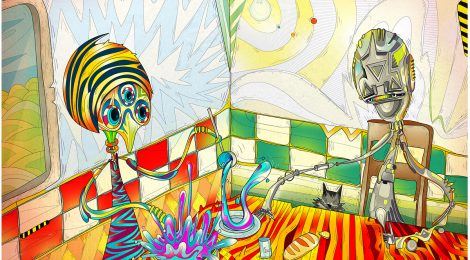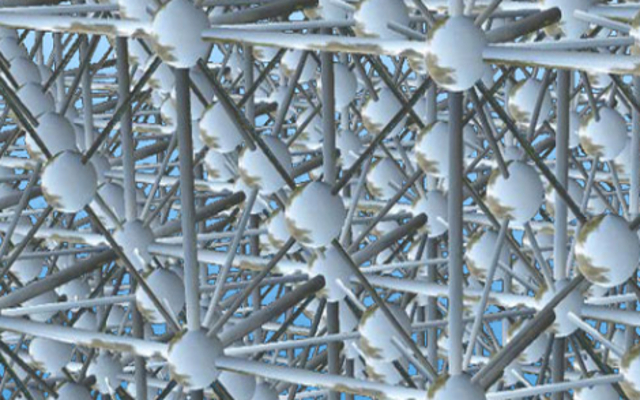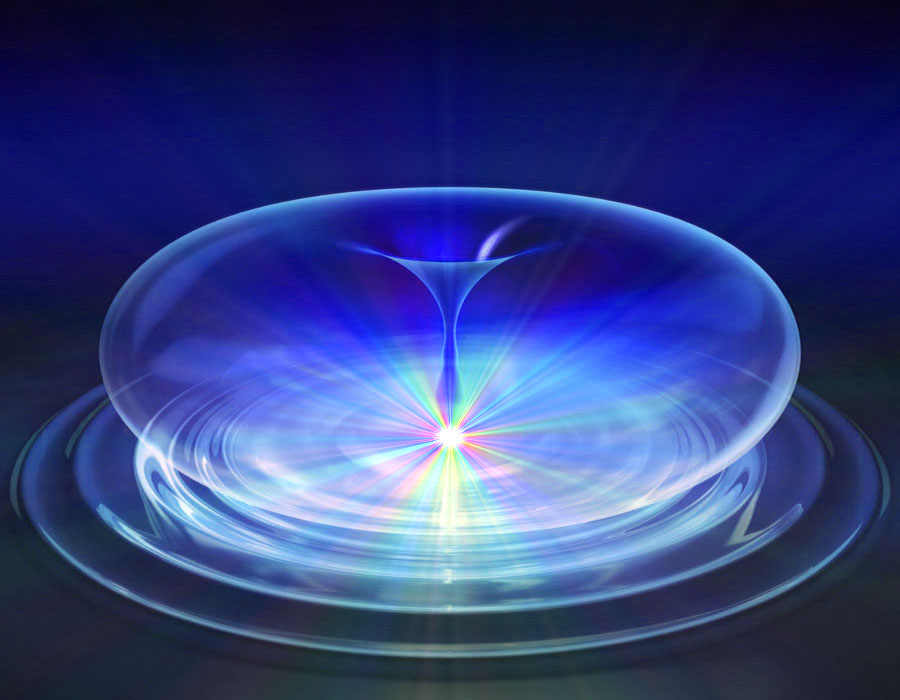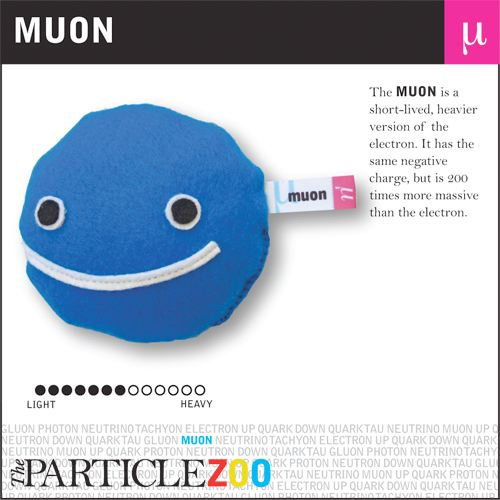
Cold Kaon Fusion
There are remarkable intersections of new physics data appearing
In the solid-state plasma world, hydrogen with densities nearing those in neutron stars is being created and manipulated with ease in Earthly laboratories.
This ultra-dense, terapascal, ‘Rydberg’ hydrogen is the magic that leads to cold koan fusion, which may be the least of its wonders.
Banner image of Strangelet Quark Soup Matei Apostolescu/013a.com
Until just now, spring 2016, it was formerly thought that only via the mind scape in theoretically constructed environments, aka mathematics, might strange, or even strangelet, quark matter particles (like stable/cold kaons) form and survive with lifetimes billions/trillions of times longer than ordinarily seen or even imagined possible. Such a state of matter is what makes up astronomical and earthly quark soup, complete with lumps and tidbits. Rather like Italian wedding soup that self heats via cold kaon fusion.

Neutron star profile may also correct be for nano-neutron stars now being produced via ultra-dense hydrogen! click to enlarge
Some of the most astonishing results being reported are those of Homlid and Olafsson who are readily able to produce on demand ultra-dense hydrogen/deuterium (Rydberg matter) with astronomical densities of stars perhaps even neutron stars. Once formed this new state of matter, close to quark matter, is ready and able to undergo fusion with the emissions not of neutrons but of muons! (An April 16, 2016 APS slide presentation by Olafsson is here.)
The cold kaon fusion happens with the most innocuous of stimulation or sometimes with no stimulation at all! The tell-tale undeniable signature of cold kaon fusion is the emission of strange muons. Here’s some food for thought if you have ever wondered what is the real secret reason behind the wild race in high energy physics made possible in the giant machines at CERN and in the now planned CERN++ machines in China and Russia. It’s very likely the unspoken truth and reason for the excitement and billions being invested in the race is all about making quark soup and the wonders in energy it makes possible. You think the anti-matter ‘Angels and Demons’ of the DaVinci code was some hot stuff, hold on to your hat!
Looking back over more than 25 years of ‘cold fusion’ investigations it is becoming clear that what the late great Nobel prize winners in Physics who have been my mentors and confidants Schwinger, Pauling, Schalow, Teller, and Taylor had noted that surely a quantum state phenomenon would accommodate cold fusion. Such a quantum state of matter is the essence of quark soup. Quarks are tiny sub-atomic particles/waves that when clustered together become what we know as neutrons, protons, and electrons as well as the rest of the critters in the sub-atomic zoo.
Quarks
Things just don’t come any more unusual than Quarks as their names, somewhat like the dwarfs in Snow White suggest are – Up, Down, Strange, Charm, Truth (aka Bottom), and Beauty (aka Top)! In fact in 1964, Murray Gell-Mann and George Zweig suggested that hundreds of the sub-atomic particles known at the time could be explained as combinations of just three fundamental particles. Gell-Mann chose the name “quarks,” pronounced “kworks,” for these three particles, a nonsense word used by James Joyce in the novel Finnegan’s Wake – Three quarks for Must Mark.
That the insides of atoms seem to be made up of combinations of quarks is the prevailing dogma in physics but there is an always present alternative theory that inside an atom the quarks are not associated into clusters at all but rather remain all individually on the loose as if forming a bag of quarks aka the Bag Model. Only when we knock atoms apart which takes a mighty amount of energy to the quark pieces stick together and we see them as the wildlife of the sub-atomic particle zoo.
Neutron and Quark Stars Macro & Micro And Cold Slow Fusion
While neutron stars are by definition astronomically large and are known to be kaon factories it seems they might in some cases really be quark stars. That’s very strange stuff indeed, in fact, some of it is ‘strangelet stuff.’ But what the new research is showing and what the 25+ years of cold fusion has revealed is that these or very similar states of matter can be formed in microscopic, nay nanoscopic domains in the spaces in between the atoms of metals! There is an old cold fusion paper by Dufour that perhaps speaks to the defining characteristics of the pico-meter environments of ultra-dense hydrogen resulting in a massive increase of gravity found in miniscule domains common to atom-ecology.

A palladium metal lattice has lots of room in between metal atoms for tiny hydrogen to reside and even force the metal to cooperate with cold fusion!
That inter-atomic space is perishing small so it leads us to reduce just what sort of matter can get into those tiny spaces, and that leaves us surely with hydrogen and perhaps a few of its closest midget elements/isotopes on the periodic table. Cold fusion from its first announcements was described by Martin Fleischmann as being enabled by progressively loading deuterium into the metal palladium which loves to absorb hydrogen beyond all others until it reached a density exceeding the density of the metal host and attained the density of metallic hydrogen and perhaps more. Now we know ‘more’ is the right view.
It’s important to give Fleischmann ( and his understudy Pons) credit for being able to create ultra-dense deuterium which in a palladium lattice they observed reached what they called a ‘gamma’ phase. Far more dense than the known ‘beta’ phase. That gamma deuteride was surely ultra-dense, achieving star-like terapascals, an achievement few cold fusion chefs have been able to match Fleischmann’s ‘master chef’ skills at preparing such exotic stuff.

Sonofusion asymmetric bubble collapse
Note in my sonofusion asymmetric bubble collapse work (and the symmetric bubble collapse sonofusion of Taleyarkhen) it is clear similarly or even higher density, terapascal, hydrogen/deuterium is found in the collapsing bubble wall and vortex and in my work associated metal target materials into which that ultra-dense deuterium was injected where massive fusion and production of 4He occurred.
Caterwauling Nonsense
When ‘cold fusion’ was announced the major caterwauling opposition centered on the expected energetic radiation that was missing. Experience with fusion as politically correctly professed at the time demanded intense neutron and gamma radiation such that a fraction of a watt of fusion energy would produce a lethal dose of said radiation.
Cold fusion researchers including myself laboured for decades to measure the expected cold fusion neutrons or any radiation at all with nary a result. Perhaps a few instances of very odd and unexplained radiation were seen, in my case working with Edward Teller (father of the hydrogen bomb) we described what Teller named my ‘mischugenons’ or crazy particles. After some communications with Homlid and Olafsson and gleaning what I could from their ‘crazy heavy cold muons’ I am near to believing our crazy particles may be variations of the same thing.
Muons are most commonly known and studied as they are commonly formed when cosmic rays enter the Earth’s atmosphere and from the decay of kaons! In this case they are very energetic and short-lived with a decay time of a few milliseconds. Such muons are moving very fast, hot, in the realm of speed where in a nano-second the distance they would travel through matter is about the width of your laptop screen they go a very long way in their 22 micro-seconds or 22 million nano-second life/travel time. As such they can be hard to measure. Ordinary radiation detection tools don’t measure up to the task.
In the case of what I now hypothesize is cold kaon fusion the muons produced are also ‘cold’ and as such while moving very much slower have a vastly longer lifetime. These will behave almost completely outside of our normal expectations for radiation emissions, a very crazy particle indeed. This is what sent a Eureka thrill though me when I read the Homlid and Olafsson paper.
Rare Radiation in Cold Kaon Fusion
My own work had only seen radiation from my ultra-dense Rydberg hydrogen cold fusion experiments in a wildly unexpected fashion which by the way was how I received a cold call from Edward Teller inviting himself into my confidence and lending me the benefit of his incredible knowledge.
Fortunately for cold kaon cold fusion the mischugenon emissions are nigh unto neutrino-like in their interaction with matter including nearby researchers like myself. While they behave a little bit like neutrons in detection they must be far less engaged with the matter and people they pass through. In my own case Teller and my calculations suggested my personal experiment neutron exposure at some 1000 Sieverts, more than lethal yet 20 years later here I am hale and healthy – whew.
For aspiring cold fusion chefs looking to try their hand at some of this venues crazy cuisine here’s a link to the Ultimate Cold Fusion cooking school.

Rossi checking with his stethoscope on the sound of his E-CAT (and mouse) on his megawatt output E-CAT Power Plant that has reportedly powered an American factory for 350 days yielding as much as 50 times to power output as power input required. Of course, an industrial scale law suit is now in the works and it seems a judge will decide if Rossi’s game of cat and mouse is real. click to read more
Rossi’s Game of Cat and Mouse
Here’s a really interesting bit that might connect some of the puzzle pieces in the present day Rossi E-CAT work and mystery of what Rossi teases the world with and names his vital ‘cat and mouse’. Rossi says the mouse is needed to stimulate the cat to run, or at least to run as a Hot-Cat. The mouse, if real, is likely some ‘nudge’ that is provided to the ultra-dense Rydberg hydrogen which is very likely in a state of matter somewhere in the realm of a superconductor Bose Einstein Condensate. The ‘cat’ being buried within metal in a reactor that is hundreds of degrees celsius, red-hot at the least it very inaccessible so this mouse is perhaps better described as a ‘Cheshire mouse’.
Rossi though says he is able to, and must, provide his mouse to get the cat moving. Homlid also has such a cat toy in the form of the ever-popular simple laser that every cat finds to be an irresistible moving red dot. Very little added energy is needed. Homlid notes that to some extent even the exposure of normal room light on his cold kaon fusion mix is sufficient to get it racing.
Of Mice and Men
My own work with Teller made use of a very low-intensity light source of a particular frequency and that was enough to make startling numbers of ‘mischugenons’ and abundant release of anomalous cold fusion heat which I am happy to now try on the moniker of ‘cold kaon fusion’ heat. Other of my work involves using ultrasound to produce a sonofusion reaction that produces prodigious helium and another cold cathode technology protocol I have worked to develop somewhat similar to Rossi’s ‘cats’, or my catalyst based cold fusion that uses heat and deuterium to again produce abundant additional heat and helium as featured in a report in Wired Magazine.
Natural history and ecology of ‘strangelets.’
Strangelets are theorized cosmological objects composed of an exotic form of matter known as strange matter or quark matter. This form of matter is created in the cores of particularly dense neutron stars or ultra-dense Rydberg matter. In this domain pressure is so intense that the protons and electrons in atomic nuclei fuse to become neutrons. The resultant matter is sometimes referred to as neutronium, a sea of neutrons packed far more densely than conventional matter.
Sometimes the pressure/density becomes so intense that the neutronium collapses into its constituent particles, quarks. This results in agglomerations of so-called strange quarks bound to each other directly much in the same manner that the transition from conventional star to neutron star results in seas of neutrons bound directly together. The names physicists have given this type of matter are “quark matter” or “strange matter”. This may be regarded as a phase change, like changing from a liquid to a solid, only at densities many orders of magnitude greater than those occurring in this solar system.
It is hypothesized that strangelets (sub-stellar agglomerations of strange matter) may be able to exist independently from the domains, astronomic in size in the case of neutron stars or nanoscopic in szie in the case of ultra-dense Rydberg matter in hydrogen loaded metals, which created them. If so, there may be many strangelets in the universe at large and in the cold fusion reactors now proliferating. At the universe scale this might well be a possible explanation for dark matter.
Wonderment and Promise For Our Future
The wonderment and reality of cold fusion is that it provides a means for us to create strange new matter in devices no more complicated or expensive than a common light bulb. The promise is that cold kaon fusion will be immediately providing a clean, inexpensive, infinite source of energy to power everything the human mind might imagine!
Strange new tracks and trails in the domain of Atom-Ecology: Majorana fermions a 4th state of matter are found to be readily produced on the surface of some metals.



An excellent read. I too am watching the work of Professor Holmlid. A very interesting process that produces muons, which is totally diferent than muon catalyzed fusion. One of significant features is that muons are charged particles allowing for posible direct conversion to electrical power. One question I have though in your article, I thought the decay time of a muon was in the micro second range rather than milli second range.